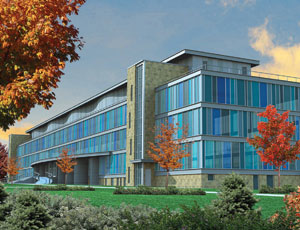...concrete instead of casting it in place. And it helps the designers by giving them a better floor-to-floor height because you don’t have beams below the slab as you do in a conventional structure.”
Cannon Design expects the building will achieve LEED gold. Architects selected regional, recycled and renewable materials, such as bamboo millwork and a brick exterior, which complements the other brick-clad buildings on campus. Signage will explain about low-flow fixtures, recycling and energy consumption.

In addition, the South Ellicott project features universal design principals. “A principal of universal design is equitable use,” Mistriner adds. “Everyone, no matter their physical abilities or disabilities, would be able to use the space, and it’s simple and intuitive.”
Desk heights and electrical outlet heights are placed at heights convenient to anyone. All the doors are the same width as required by the Americans with Disabilities Act. They will have lever handles rather than knobs. Surfaces will have different textures to help a blind person know where he or she is.
Universal design features did not add any additional cost to the project.
LPCiminelli will turn the complex over in sections, 200 rooms at a time. The project is scheduled for completion in time for classes to start in August 2011.
Also at the North Campus, Perkins + Will of Boston has designed a $65-million Computer Science and Electrical Engineering Building. The university solicited bids from contractors during the summer.
South Campus At the South Campus on Main Street in Buffalo, the Pike Co. of Rochester, N.Y., has begun a $60-million renovation of the existing Edward Goodrich Acheson Hall, built in 1957 and 1962, into John Kapoor Hall for the School of Pharmacy and Pharmaceutical Sciences.
The first two floors will contain education and administrative spaces, with two lecture halls, classrooms and a 75-station simulation laboratory, which will allow students to mix and distribute drugs. The top two floors will house research laboratories.
The 147,792-sq-ft former chemistry building had sat vacant for more than 12 years. Demolition of the interior and abatement of mercury, asbestos and polychlorinated biphenyls was completed under a prior contract.
“The only thing standing will be two existing lecture halls and the concrete frame of the main building,” says Rick Polvino, a principal with the S/L/A/M Collaborative of Glastonbury, Conn., which designed the renovations and addition. The renovated building will have 169,000 sq ft, with a new area for chillers and a penthouse to house additional air-handling equipment needed for the pharmacy laboratories.
Erdman Anthony of Rochester, N.Y., the mechanical, electrical and plumbing engineer on the project, used...

